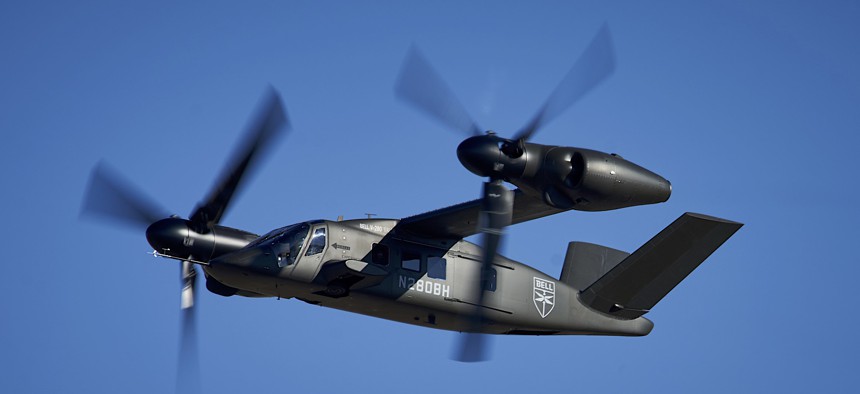
in this 2018 photo, a Bell V-280 tiltrotor flies at Bell Flight Research Center in Arlington, Texas. Bell
Army Picked Pricier Black Hawk Replacement Over ‘Unacceptable’ Losing Bid, GAO Says
The Army found Sikorsky-Boeing's offering too vague, a new GAO document says.
The Bell tiltrotor aircraft that will replace Army Black Hawks will cost at least $3.6 billion more than a Sikorsky-Boeing helicopter proposal rejected by service leaders as vague and “unacceptable,” according to a GAO document posted Thursday.
Bell’s “proposed approach to weapon system performance and design, architecture, and product supportability is more advantageous to the government than [Sikorsky], whose engineering design and development is unacceptable,” wrote an undisclosed Army official who chose the winner, according to the GAO document.
In December, the Army picked Bell’s V-280 over the Sikorsky-Boeing Defiant X for its Future Long-Range Assault Aircraft, or FLRAA, program, explaining tersely that Bell’s proposal was the “best value.” Last week, GAO announced that it had denied Sikorsky-Boeing’s protest, explaining in a short press release that the team “failed to provide the level of architectural detail required.” But the agency withheld its formal decision document until corporate secrets could be redacted.
On Thursday, GAO released a 38-page redacted version of its decision, which says the Sikorsky-Boeing bid was dismissed because the companies misinterpreted what the Army wanted.
“Sikorsky’s proposal provided something similar to a drawing of what the house looked like on the outside, a basic indication of the size and shape of the house,” the Army wrote, according to GAO. “Such a picture did not provide the functional detail that the Army required showing what the space would look like on the inside (i.e., how the system functions would be allocated to different areas of the system--for example, that food storage and preparation would be allocated to a space for the kitchen).”
The document does not appear to make a judgment about the radically different technology used on the two competing aircraft and which one would better benefit troops.
In an emailed statement, a Sikorsky spokesperson said, “We just received the GAO’s report and will take the time to review and determine our next steps. We remain confident the Lockheed Martin Sikorsky and Boeing team submitted the most capable, affordable and lowest-risk Future Long-Range Assault Aircraft solution.”



